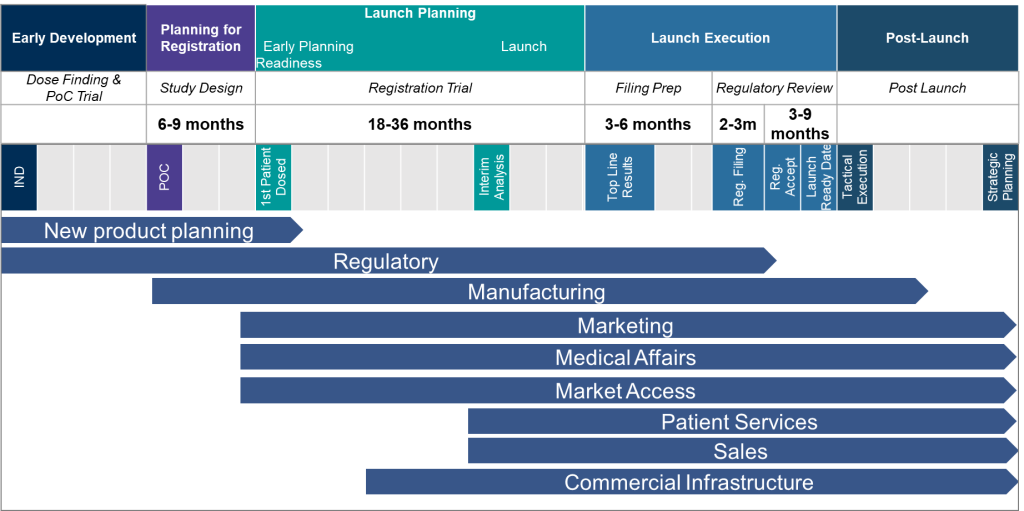Components of a pharma and biotech go-to-market strategy
After many years of drug development and getting ready for product launch you are finally at the tactical planning stage. Getting to this phase is a major accomplishment, but this does not guarantee commercial prosperity without the structure and process in place. To ensure launch success, careful attention must be paid to this component of your go-to-market strategy.
At Herspiegel we have partnered with biotech and pharma companies big and small and have successfully brought millions of dollars worth of drugs, devices, and treatments to market. But before a product goes out the door, we help launch teams set their go-to-market strategies. There are four components to each of our product launch strategies:
- Where to play?
- How to win
- How to execute
- The launch plan
Today there is a laser focus on product performance out of the gate, so there is a lot of pressure to get it right. This means pharma companies need to make sure that they have the right launch team in place before putting together the structure and tactics in their launch plans. With all the time and resources already invested into the product, the cost of failing is high. This is why pharmaceutical and biotech companies come to us to make sure that their launch plans are exactly what they need to make their products successful.
Part 4: The Launch Plan
There are four main elements to how we help our clients execute the final and most important component of their go-to-market strategy:
- The launch plan
- Launch management
- Launch readiness assessment
- Launch summit
1. Launch Plan
For each phase, the launch plan needs to be appropriate to the organization’s situation. The launch plan will gain detail as the company progresses through the launch stages. There needs to be enough planning to help inform strategic decisions and spend. As commercialization nears thirty-six months, more detailed plans help ensure appropriate market shaping and insight development at the right time.

2. Launch management
Launch planning process: Having a plan to check against, and drive timely decisions is a critical element of launch management.
When you are working on a drug launch you need to have structure and process so that the 10-20 teams involved don’t fall apart. This usually involves a governance structure that can help fortify alignment between the teams and keep the communication and information flowing.
This central governance structure will develop the launch plan and strategy, outlining critical activities and timelines involved; with all the activities being interconnected this is crucial for alignment. This allows launch teams the ability to accelerate the launch timeline while de-risking launch. Managing this plan and the team that provides operational support ultimately guides decision making during launch execution.
A Herspiegel client was two months away from launch. Our team introduced, implemented and managed a software solution to guarantee key launch assets would be available on Day 0, Day 1, Days 2 – 7 and so on.
In collaboration with AOR and other partners, we proactively identified bottlenecks. The marketing lead “owned” upwards of 70 projects pending approval. Our team triaged the project list and introduced a tiering system that reduced the brand lead’s burden significantly.
- Tier 1: Brand lead owned (e.g., CVA, website, conference booth)
- Tier 2: Herspiegel SME owned, brand lead had line of sight (e.g., journal ad, speaker deck)
- Tier 3: Herspiegel SME owned outright, brand lead was informed (e.g., banner ads)
As a result, the brand leader went from owning over six dozen projects to just nine total. Herspiegel made sure the balance of assets, which were derivative of the core assets, were routed and approved on time.

3. Launch readiness assessment
Before launching and after having a structured plan and process in place, that has been communicated to all the stakeholders it’s time to assess launch readiness.
Launch readiness should be identified across six key areas:
- Market access
- Supply chain
- Organizational
- Stakeholder
- Customer
- Marketplace
Many organizations assess their commercial readiness via a launch simulation exercise. This one to two day off-site gathers a diverse group of stakeholders that includes the brand team, market access, sales leadership, medical affairs, regulatory, global, and a handful of other cross-functional teams. Groups are assigned to companies/brands already on the market in the same area/ space as their product or treatment.
On Day 1 we assume the role of the established player and come into the meeting having completed a couple hours of pre-work (read the PI, market share and volume data, payer landscape, etc.). An example of a scenario that would be played out is: how to anticipate and react to another brand’s launch, e.g., what would be said promotionally, what tactical levers would be pulled, what should be done from a rebating standpoint.
On Day 2, we put our own brands’ hat back on and say, “OK, if the ‘other brand’ is going to do/say XYZ we need to be prepared to counter with ABC.” The workshop helps to pressure test how competitive the commercial space is, how entrenched current competitors are and the importance of current brands to their respective portfolios.
When in Launch Mode, it’s easy for companies to only be focused on what’s ahead, and the “Days to Launch ” countdown clock and not look at their blind spots. The launch simulation exercise forces companies to look at the market through an objective, competitive lens.
4. Launch Summit
The objective of holding a launch summit would be for all the stakeholders in the cross-functional teams to share key recent developments and data with a goal of aligning all the teams on current assumptions. This helps validate the launch plan.
Goals for the launch summit include:
- Pressure test final plan to identify interdependencies, gaps, and execution risks
- Ensure coordinated hand-offs and appropriate cross-functional phasing of activities
- Ensure cross-functional teams visibility, alignment, and readiness
- Resolve minor issues and flag major issues for discussion post-workshop
The stakeholders and teams that should be invited to participate are:
- Market Access
- Patient Services
- Regulatory
- Market Insights
- Sales
- Medical
- Marketing/Brand
- Corporate Communications
- Trade/Distribution
- Commercial Ops
- R&D
The launch summit sets the tone for the company and product team and says a lot about the organization’s culture. Some companies will throw a big party and make it fun and others will make it all business with a 12-14 hour workday. Ultimately, it’s an opportunity for leadership to set both the tone and expectations for their teams.
An example of good content for a launch summit would include the following:
- A patient testimonial (live, if possible)
- Market landscape overview from a key opinion leader (KOL)
- A discussion of unmet needs and opportunities for the launch
- Presenting differentiating attributes that will be reinforced during sales training workshops
- Methods for navigating “pillars & potholes” which are the attributes HCPs like about the product and the Achilles heels the competition will be whispering about
- A workshop on Key Performance Indicators, or what good looks like for sales and how to hold themselves accountable
- Sales teams should talk through local challenges at the regional level
The output of the launch summit should provide a final launch plan that is aligned cross-functionally and pressure-tested for gaps and inconsistencies. The program-level risks and challenges will be identified for the Core Team to prioritize post-summit and pre-launch. Each Expert Team should walk away with a clear set of interdependencies, risks, and open questions. At a good launch summit, the leadership wraps up with a rallying cry and call to action. Launch meetings are inherently exciting and should be celebratory.
Summary
The drug launch landscape has become increasingly complex. A crowded and competitive market for both product and people and on top of that there are incoming changes to legislation that will force new pricing strategies that might upend many months of planning.
With all of this in mind, pharmaceutical and biotech companies have to stay focussed on executing their product launches that have been many years in the making. Having the right team and the right components to your go-to-market strategy can de-risk launch and allow companies to focus on the details of getting their products to market one step at a time. A successful product launch trajectory is built in the 12-18 months before launch.
The launch plan is the fourth and final part of our series on ‘Navigating a Drug Launch in 2022.’ You can go back and read parts 1-3 here:
Let us know if you have any questions about what it takes to create a winning go-to-market strategy, we are here to help make sure your product launch is a success.


